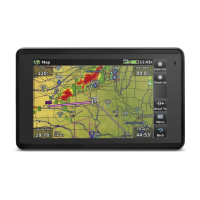Garmin aera 660 Pilot’s Guide
190-02017-20 Rev. E
6
Overview
OverviewNavigationFlight PlanningHazard AvoidanceAdditional FeaturesAppendicesIndex
SATELLITE INFORMATION
Satellites currently in view are shown at their respective positions on a satellite
constellation diagram. The outer circle of the constellation diagram represents the
horizon, the inner circle represents 45° above the horizon, and the center point shows
the position directly overhead. Each satellite is represented by a square containing the
Pseudo-Random Noise (PRN) number (i.e., satellite identification number).
GPS Info can be helpful in troubleshooting weak (or missing) signal levels due to
poor satellite coverage or installation problems. As the receiver locks onto satellites, a
signal strength bar is displayed for each satellite in view, with the appropriate satellite
PRN number (01-32; 33-64 for WAAS; 65-99 for GLONASS) below each bar. The
progress of satellite acquisition is shown in three stages, as indicated by signal bar
appearance:
- No bar—Receiver is looking for the indicated satellite
- Gray bar—Receiver has collected the necessary data and the satellite signal can
be used
- Green bar—Satellite is being used for the GPS solution
DISPLAY ORIENTATION
The aera 660 can be viewed in either Portrait or Landscape Mode.
Changing the display orientation:
1)
From the Main Menu, touch Tools > Setup > Display
Or
:
Press the Power Button once quickly.
2)
Touch Landscape or Portrait.

